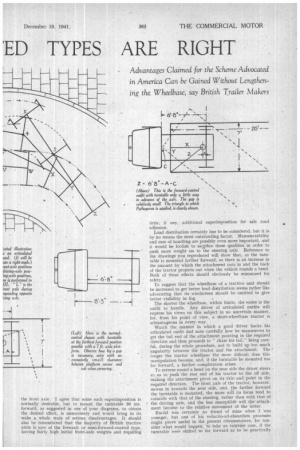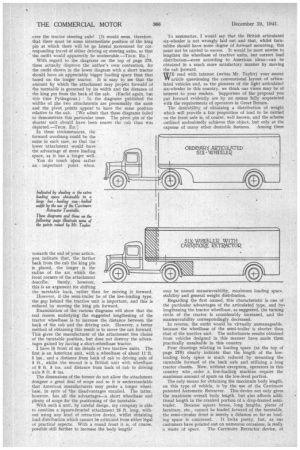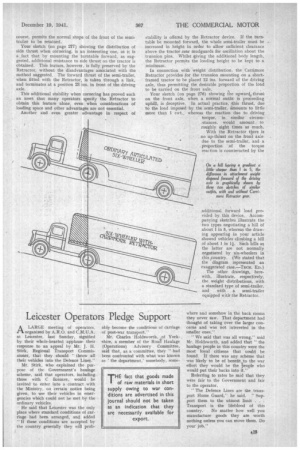WHY BRITISH ARTICU1 'ED TYPES ARE RIGHT
Page 28

Page 29

Page 30

Page 31

If you've noticed an error in this article please click here to report it so we can fix it.
MUCH interest has been aroused by the article entitled "Is the Articulated Six-wheeler Wrongly Laid Out? " which appeared in opur issue dated
'November 14. Some criticism has been expressed of the views put forward, and we have received a number
of letters in defence of the usual practice of British ,makers of machines of the type under consideration.
In respect of weight distribution, it is pointed out in at least one quarter that forward control or semi-forward control is far more widely employed in this country than in America, so that what applies there is not necessarily applicable here. With the very short wheelbase Per mitted by the forward driving position, front-axle load ing is higher at the outset. Manceuvrability, it is streSsed, is greatly impaired by lengthening the tractor wheelbase and moving forwards the turntable, whilst reversing becomes a matter of increased difficulty from the same cause. .
We publish in the following articles the views of two leading specialists, viz., Mr. A. Illarenbon, A.M.Inst.T.,
R. A. Dyson and Co., Ltd., and Mr. J. A. Taylor, assistant managing director, Carrimore Six Wheelers, Ltd.
WHILsT I was much interdsted, writes Mr. garenbon, in the article in your issue of November 14, under the title " Is the Articulated Six-wheeler Wrongly Laid Out? " it
does occur to me that the author has written it with his tongue in his cheek rather than as a serious suggestion that British articulated six-wheelers are wrongly designed. Pos sibly his greatest error lies in his tacit assumption that turntables of articulated outfits are invariably mounted almost immediately, over the tractor driving axle and that load and weight distribution do not receive consideration. This is far from being the case, and you can take it for granted that every British manufacturer of articulated outfits does consider all the various factors.
To take a single example, my company manufactures a fair proportion of the semi-trailers in use in this country, and, we like mounting the turntable from 6 ins. to 9 ins.
forward. In some cases this amount is increased to 12 ins., but-each outfit has to be considered upon its merits, taking into account all the various factors, such as body space required, type of tractive unit, load to be carried, etc.
A wheelbase of from 8 ft. 6 ins. to 11 ft. 6 ins, seems to be most common on tractors, and it will be readily appreciated that mounting the turntable even so little as 6 ins, forward does superimpose a definite portion of the load on the front axle. I agree that some such superimposition is normally desirable, but to mount the turntable 30 ins. forward, as suggested in one of your diagrams, to obtain the desired effect, is unnecessary and would bring in its wake a whole train of serious disadvantages. It should also be remembered that the Majority of British tractive units is now of the forwardor semi-forward-control type, having fairly high initial front-axle weights and requiring little, if any, additional superimposition for safe road adhesion.
Load distribution certainly has to be considered, but it is by no means the most outstanding factor. Manmuvmbility and ease of handling are possibly even more important, and it would be foolish to sacrifice these qualities in order to push more weight on to the steering axle. Reference to the drawings you reproduced will show that, as the turntable is mounted farther forward, so there is an increase in the amount by which the attachment cuts in and the back of the tractor projects out when the vehicle rounds a bend. Both of these effects should obviously be minimized for safety.
To suggest that the wheelbase of a tractive unit should be increased to get better load distribution seems rather like advocating that its windscreen should be omitted to give better visibility in fog.
The shorter the wheelbase, within limits, the easier is the outfit to handle. Any driver of articulated outfits will express his views on this subject in no uncertain manner, for, from his point of view, a short-wheelbase tractor is advantageous in every way. • Watch the, manner in which a good driver backs his articulated outfit dnd note carefully how be manceuvres to get the tail end of the attachment pointing in the required direction and then proceeds to " chase his tail," being careful, during the whole procedure, not to build up .too much angularity between the tractor and the attachment. The longer the tractor wheelbase the more difficult does this manipulation become, and, if the turntable be mounted too far forward, a further complication arises.
To reverse round a bend on the near side the driver steers SD as to push the rear end of his tractor to the off side, making the attachment Pivot on its a.-xle and point in the required direction. The front axle of the tractor, however, moves in towards the near side, and, the farther forward the turntable is mounted, the more will. its locus tend to coincide with that of the steering, rather than with that of the driving axle, and the less susceptible will the 'attachment become to the relative movement of the latter.
Euclid was certainly no friend of mine when I was younger, but one of his reductio-ad-absurduna processes might prove useful in the present circumstances, for consider what would happen, to take an extreme case, if the turntable were shifted so far forward as to be practically over the tractor steering axle! [It would seem, therefore, that there must be some intermediate positiOn of the king pin at which there will be no lateral movement for corresponding travel of either driving or steering axles, so that the outfit would apparently be unsteerable.—Tecm. En.] With regard to the diagrams on the top of page 278, these actually disprove the author's own contention, for the outfit shown in the lower diagram with a short tractor should have an appreciably bigger loading space than that based on the longer tractor. It is easy to see that the amount by which the attachment may project forwaiel of the turntable is governed by its width and the distance of the king pin from the back of the cab. (Euclid again, but this time Pythagoras.) In the diagrams published the widths of 1.he two attachments are presumably the sam and the pivot points appear to have the same position relative to the cab. [We admit that these diagrams failed to demonstrate this particular issue. The pivot pin of the shorter unit should have been nearer the cab than depicted.—TECH. En.] In these circhmstances, the forward overhang .could be the same in each case, so that tne lower attachment would -have the advantage of more leading space, as it has a longer well.
You do touch upon rather an important point when, towards the end of your article, you indicate that, the farther back from the cab the king pin is placed, the longer is the radius of the arc which the front corners of the attachment describe. Surely, however, this is an argument for shifting the turntable back, rather than for moving it forward.
However, if the semi-trailer be of the low-loading type, the gap behind the tractive unit is important, and this is reduced by moving the king pin forward.
Examination of the various diagrams will show that the real reason underlying the suggested lengthening of the tractor wheelbase is to increase the distance between the back of the cab and the driving axle. However, a better method of obtaining this result is to move the cab forward. This gives the manufacturer of the attachment free choice of the turntable position, but does not destroy the advantages gained by having a short-wheelbase tractor.
I have in front of me details of two tractive units. The first is an American unit, with a wheelbase of about 11 -ft. 5 ins., and a distance from back of cab to driving axle of 5 ft., whilst the second is a British unit with wheelbase of 8 ft. 5 ins, and distance from back of cab to driving axle 6 ft. 8 ins.
The dimensions of the former do not allow the attachment designer a great deal of scope and so it is understandable that American manufacturers may prefer a longer wheelbase, in spite of 'the disadvantages entailed. The latter, however, has all the advantages—a short wheelbase and plenty of scope for the positioning of the turntable.
With such a unit, by careful design, my company is able to combine a Square-fronted attachment 26 ft. long, without using any kind of retractive device, whilst obtaining load distribution which cannot be criticized from either legal or practical aspects. With a round front it is, of course, possible still further to increase the body length! To summarize, I would say that the British articulated six-wheeler is not wrongly laid out and that, whilst turntables should have some degree of forward mounting, this must not be carded to excess. It would be most unwise to lengthen the wheelbase of tractive units, but correct load distribution—even according to American ideas—can be obtained in a mnch more satisfactory manner by moving the cab forward.
WE read with interest (writes Mr. Taylor) your recent VV article questioning the conventional layout of articulated vehicles and, as the pioneers of the light articulated six-wheeler in this country, we think our views may be of interest to your readers. Supporters of the proposal you put forward evidently, are by no means fully acquainted with the requirements of operators in Great Britain. The desirability of obtaining a distribution of weight which will provide a fair proportion of load to be carried on the front axle is, of course, well known, and the scheme outlined undoubtedly achieves this object, but only at the expense of many other desirable features. Among these may be named manceuvrability, maximum loading space, stability and general weight distribution.
Regarding the first named, this characteristic is one of the particular advantages of the articulated type, and byi lengthening the tractor wheelbase, as suggested, the turning circle of the tractor is considerably increased, and the manoeuvrability correspondingly decreased.
In reverse, the outfit would be virtually unmanageable, because the wheelbase of the semi-trailer is shorter than that of the tractive unit.. The unfortunate results obtained from vehicles designed in this manner have made them practically unsaleable in this .country. ,
Four drawings relating to loading space (at the top of page 278) clearly indicate that the length of the lowloading body space is much reduced by mounting the turntable forward of the back axle and utilizing a long tractor chastis. Now, without exception, operators in this country who, order .a low-loading machine require the maximum amount of space on the low-level portion.
The only means for obtaining the maximum body length, on this type of vehicle, is by the use of the Carrimore patented Automatic Retractor. This device not only gives the maximum overall body length, but also affords additional length in the cranked portion of a drop-framed semi
trailer. Because square boxes, long lengths, pieces of furniture, etc., cannot be loaded .forward of the turntable, the semi-circular front is merely a delusion so far as load
ing, space is concerned. It looks pretty, but, as our customers have pointed out on numerous occasions, is really a waste of space. The Carrimore Retractor device, of course, permits the normal shape of the front of the semitrailer to be retained.
Your sketch (on page 277) showing the distribution of side thrust when cornering, is an interesting one, as it is a ,fact that by mounting the turntable forward, as suggested, additional resistance to side thrust on the tractor is obtained. This feature, however, is fully preserved by the Retractor, without the disadvantages associated with the method suggested. The forward thrust of the semi-trailer, when fitted with the Retractor, is taken through a link, and terminates at a position 23 ins. in front of the driving axle.
This additional stability when cornering has proved such an asset that many operators specify the Retractor to obtain this feature alone, even when considerations of loading space and other advantages are not essential.
Another and even greater advantage in respect of stability is offered by the Retractor device. If the turntable he mounted forward, the whole semi-trailer must be increased in height in order to allow sufficient clearance above the tractor rear mudguards for oscillation about the trunnion pins. Whilst giving the additional body length, the Retractor permits the loading height to be kept to a minimum.
In connection with weight distribution, the Carrimore Retractor provides for the trunnion mounting on a shortframed tractor to be placed 12 ins, forward of the driving axle, thus permitting the desirable proportion of the load to be tarried on the front axle.
Your sketch (on page 276) showing the upward, thrust on the front axle, when a normal outfit is proceeding uphill, is deceptive. In actual practice, this thrust, due to the load imposed by the semi-trailer, d,mounts to little more than 1 cwt., whereas the reaction due to driving torque, in similar circumstances, would amount to roughly eight times as much.
With the Retractor there is no up-thrust on the front axle due to the semi-trailer, and a proportion of the torque reaction is counteracted by the
On a hill haying a gradient a little steeper' than I in 5, the difference in attachment weight disposed forward of the driohw axle is graphically shown by these two sketches of similar outfits, with and without Carri more Refractor gear.
additional forward load provided by this device. Accompanying sketches illustrate the two types negotiating a hill of about I in S. whereas the drawing appearing in your article showed vehicles climbing a hill of about I in 11. Such hills as the latter are not normally negotiated by six-wheelers in this country. (We stated that the diagram represented an exaggerated case.—TEma. En.) The other drawings, herewith, illustrate, respectively, the weight distributions, with a standard type of semi-trailer, and with a semi-trailer equipped with the Retractor.
























































